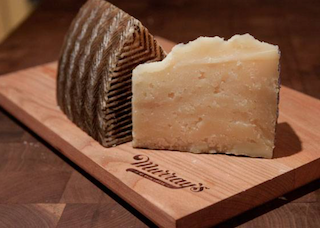
Baker’s Dozen of Cheeses
There are quite a number of questions we ask when we visit the shop for the first time. But don’t feel uncomfortable. Everyone has to start somewhere, and you are lucky—you are in the right place, so read on.
We'll tell you what is considered to be the list of 13 cheeses that any cheese lover should know. There are many different types of cheese, with their price ranging from rather cheap to prohibitively expensive. Three of the major types of milk are used in the cheese production: cow, goat, sheep, or a blend of these milks.
Here’s the list:
- Roquefort
- Camembert
- Cotija
- Chevre
- Feta
- Mozzarella
- Emmental
- Cheddar
- Gouda
- Taleggio
- Parmigiano-Reggiano
- Manchego
- Monterey Jack
We’ll consider each cheese in the list with the following aspects in mind:
Country of origin: The country of origin where the cheese was first discovered. In some cases, cheeses have a protected geographical status, meaning that the cheeses are made in certain regions and under strict control. The examples of such cheeses are Roquefort and Manchego. Other cheeses, such as Gouda, also originate from a certain area but are produced all over the world. Of course, the latter category will vary more in their taste qualities than the protected cheese.
Milk type: Cheese always starts with milk, but the animal it came from makes big differences in the final flavor. Cow’s milk is the softest milk, with a creamy, sweet flavor, which adds a subtle pleasant flavor to the cheese. Therefore, aging and ripening play a significant role in the development of taste in these cheeses. Sheep’s milk has a mild grassy taste, less creamy than cow’s milk. Goat’s milk is the most diverse and depends on the specific hay and grass.
Aging: Most cheeses age over a certain period of time at a controlled ambient temperature. During this process, moisture evaporates, resulting in a thick paste and a more intense flavor. Bacteria work so that the protein is slowly digested, transforming the texture of a cheese into grainy, crumbly, smooth, or creamy. On the outside, bacteria help to form the rind and enhance the flavor.
Taste notes: Here we will discuss what to expect when you taste a piece of cheese and what key characteristics to expect.
How to use: Is the cheese good as is, or should it be cooked and served as part of special dishes? Should it be served with specific drinks?
There are thousands of cheeses around the world and, of course, this list is incomplete, but it gives a general idea on the basics.

1. Roquefort
Country of origin: France
Type of milk: Sheep’s milk
Aging: At least 5 months
The blue potholes of mold that cover the cheese are colonies of the Penicillium Roquefort mold found in the natural environment of the caves of Roquefort, France. It has a moist, crumbly texture with obvious grassy notes of sheep’s milk. It is best to try it in the fall, when cheese is made from fresh spring milk.
How to use: It is good as is, but also tastes well with nuts and honey.

2. Camembert
Country of origin: France (Normandy)
Type of milk: Cow’s milk
Aging: At least three weeks
The outer rind is a layer of bacteria called Penicillium Candidum. Under a microscope, the bacteria resemble dandelions. As the most produced French cheese, it has different qualities that vary significantly under the influence of different factors. Some handmade cheeses have protected trademarks, while others are mass-produced from pasteurized milk. Since the aging period is very short (three weeks only), you will never find “raw” cheese. The rich, buttery and spreadable texture has a mild, mushroom flavor.
How to use: It is best as is, on sandwiches or even deep-fried.

3. Cotija
Country of origin: Mexico
Aging: At least three months
Young cheeses are soft and salty, a bit like young Feta. More aged cheeses have a nutty and drier, coarser texture.
How to use: It is good with salads, tacos, soups, rice, or guacamole.

4. Chevre
Country of origin: France
Type of milk: Goat’s milk
Aging: Varies
The French word chèvre is literally translated as ‘goat’ and is used to refer to any cheese made from goat’s milk. Fresh goat cheese is usually moist, it has bright sour flavors with a lemon aroma and a slightly chalky aftertaste. It is sold in vacuum sealed packaging, sometimes seasoned with herbs, spices, or garlic.
How to use: You can crumble it into salads, or you can fry it a bit and use it on sandwiches.

5. Feta
Country of origin: Greece
Type of milk: Sheep and goat’s milk
Aging: About three months
Feta is one of the world’s cheeses that has a protected designation of origin, meaning that only authentic cheese may bear the name FETA, if it is produced on the Greek mainland or the island of Lesbos, and if it is made from at least 70% sheep’s milk (and 30% goat’s milk). Brined cheese is obtained by soaking fresh cottage cheese in salt water. Moist cheese can range from completely crumbly to creamy.
How to use: Baked with olive oil, crumbled in salads and sandwiches. It is also sometimes used instead of Cotija in Mexican dishes.

6. Mozzarella
Country of origin: Italy (Campania)
Type of milk: Cow’s, buffalo’s milk
Aging: None
Mozzarella is a fresh squeezed curd made from buffalo’s milk (Buffalo Mozzarella) or cow’s milk (Mozzarella Fior de Latte). The creamy mixture is heated in warm water and stretched by hand before forming the famous balls. The cheese balls are sold as is or packaged in salt water bags. The fresh and rich milky taste add value to Mozzarella due to its texture and creamy taste.
How to use: Fresh with olive oil, salt and pepper. With tomatoes in sandwiches and, of course, on pizza!

7. Emmental
Country of origin: Switzerland
Type of milk: Cow’s milk
Aging: At least four months
Emmental is what people imagine when they hear the words “Swiss cheese” (yes, it’s all about these very holes). It is called Alpine or Mountain because cows graze for several seasons there, cottage cheese is produced from their milk and it is subsequently pressed together. The holes in the cheese are bubbles of carbon dioxide gas produced by bacteria. The cheese has a certain sweetness and piquancy, which is felt by the back of the tongue on the finish. Like all Alpine cheeses, it melts perfectly well.
How to use: Fondue, grilled cheese.

8. Cheddar
Country of origin: England
Type of milk: Cow’s milk
Aging: There is no minimum aging, but it is better if it is aged for a year or more
Cheddar is a cow’s milk cheese originated from Somerset (England). Cheddar is not only a noun, but also a verb, meaning the process of cheese-making, when the curds are cooked and crushed into rice-size crumbs. The pieces are then pressed into large blocks, and the blocks are placed one on top of the other to squeeze out the remaining moisture. Cheddar cheese prepared in this way turns out dry and crumbly, with a deep acrid, nutty taste. Cheddar-style cheeses are very different, so it would be a good idea to discuss them with a seller in your shop. The color ranges from ivory to straw, dark yellow, depending on the season and the livestock feeding.
How to use: As is, in sandwiches, grilled.

9. Gouda
Country of origin: Holland
Type of milk: Cow’s milk
Aging: At least four weeks, but good samples are aged one year
Gouda is a semi-hard or hard cheese made from cow’s milk from Holland. Like Cheddar, its quality and taste can vary from a soft creamy texture to very firm, crumbly and very flavorful samples. Very ripe cheeses have a crunchy texture due to the crystals of concentrated calcium lactate and amino acids that appear when the cheese loses moisture, just like good Parmesan.
How to use: Young cheeses melt well, while aged cheeses can be grated to be added to pasta and salads.

10. Taleggio
Country of origin: Italy (Lombardy)
Type of milk: Cow’s milk
Aging: Six to ten weeks
For thousands of years, Taleggio has been one of the world’s oldest soft cheeses. It was created by monks. The story is that monks repeatedly washed cheese wheels to make them clean, which caused the mold to develop even more faster. They did not realize that they foster bacteria growth both inside and outside the cheese, contributing to an acrid taste and a pungent smell. Taleggio smells like... feet. Fragrant, juicy, fleshy... feet. The soft rind of the cheese is edible.
How to use: As is.

11. Parmigiano-Reggiano
Country of origin: Italy
Type of milk: Cow’s milk
Aging: At least a year
There are a number of hard cheeses on the market that are sold under the name Parmesan. They should not be confused with the original Parmigiano-Reggiano, a protected trademark that can only be produced in the provinces of Emilia-Romagna and Lombardy in Italy. Aged one year and up to a maximum of three years, this cheese has a hard, dry structure, with a caramel and spicy flavor. And in the heyday of Italian banking, it was used as collateral for loans.
How to use: Grated in salads, and harder chesses taste well in soups.

12. Manchego
Country of origin: Spain
Type of milk: Sheep’s milk
Aging: 60 days to two years
Made from the milk of Manchega sheep. Small cheeses that range in color from ivory to straw yellow. Young cheeses have a creamy rich texture, while more aged versions develop deep salty notes.
How to use: As is or with Spanish quince paste.

13. Monterey Jack
Country of origin: USA (California)
Type of milk: Cow’s milk
Aging: About a month
Very soft and buttery taste, Monterey Jack is one of the few American cheeses. Due to its young age and relatively high milk fat content, it is good for melting. It is often mixed with hot chili peppers to produce Pepper Jack Cheese.
How to use: Melted with pasta, grilled, as a dip. In any situation when you need a good-melting cheese.
By paying attention to the basic cheese types, you will quickly understand which cheeses you like best and which are not your favorite options. And next time while in the shop you can safely claim the title of a connoisseur!

